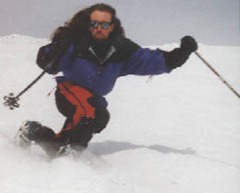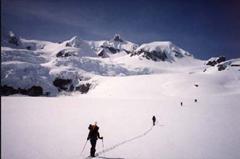On ski widths
I was out ski touring yesterday in a very popular area, one that I pretty much learned to ski in. I was musing about changes in skiing in the last 20 years.
When I first visited this area, we would be traveling in ski tracks from the parking lot – the trip up was just parallel tracks, and the trip down was often terrifying for a new skier in that the tracks were narrow, and when conditions were bad (for a new skier bad is most of the time) it was a huge 20 minute snowplough down the old road. We called this track the “luge”. It was almost impossible to make a turn.
We never saw a snowshoer in those days, except once when I saw the bravest and most cutting edge snowboarders I ever met – back when snowboarding was still being outlawed, these two snowshoed into the Elfin Lakes hut carrying their boards on tiny backpacks. I often wonder what became of them.
Cut to yesterday; it’s very common to see snowshoers in this area, and the track to the Red Heather area is wide and easy to ski out on; it’s easy to turn and stop. I thought this was because I am a much better skier now, but when I take beginners to this area I used to warn them about the “luge”, and I find that the warning is not warranted any more.
The other major change from way back then is that skis are roughly twice the width now. Could this account for the wider, easier to ski track out from Red Heather? Just like snowboards clear the powder from ski runs (much to the chagrin of skiers), perhaps the wider, heavier and easier to turn planks are responsible for the groomed quality of the old trail.
On the subject of ski widths, I was reading this review on WildSnow.com and I came across the following quote from Ski Guide and guidebook writer Martin Volken:
“If I’m looking at one do-it-all ski, then I’m looking for something that’s 85 to 90mm under foot… From guiding I’m fairly confident that going lighter and skinnier (85 to 90mm skis) than the current ‘fatter is better’ mentality is significantly more efficient. Maybe that doesn’t matter on a day trip, but when I’m out with clients who are stacking up 6 hard days in a row, efficiency matters to them by Day 3. Likewise when I’m guiding for 20 straight days, the skis that average things out the best and accomplish the most work for the least effort become really important to me.”
— interview with Martin Volken
Now I have a history of longish ski traverses in my background, where 10 days is longish (I know this is relative; compared to most weekend routes, it’s long, but compared to massive 60 day routes it’s tiny). I’ve been saying this about skis for many many years. In backcountry skiing you spend 90% of your time going uphill, and unless you’re in a very popular area, you’re breaking trail doing it. Not all of us are ski guides, who break trail for their clients all the time, but all of us could benefit from their advice.
I’ve been looking at the trend in backcountry skis with much dismay as they get fatter and heavier. The only good thing is that boot and binding offerings have been getting lighter, for AT Gear at least. I think the width trend has been following the downhill trend; if you don’t have to walk uphill, a heavy ski can be a very good thing, The other factor is that there are less fully self propelled skiers now – many of then are heli-skiing, getting heli-drops, cat skiing, or snowmobile assisted skiing; most are just “slackcountry” skiing. Under these circumstances you may not even need touring boots and bindings.
In the words of guide Volken, there may only be a few days a year where those fat skis are worth it. And as I mention in my post on snowshoe accidents (reference the sidehill image), in firm or icy conditions the large platform underfoot decreases your ability to edge properly. This is why alpine racers still use a narrower ski.
I have to say all I can do here is echo the guide’s opinions, most of which I believe are common sense. You would do well to read the interview yourself.
Meanwhile, I’m using my Movement Red Apple 74’s for the next few tours.



Nice information, but isn’t Red Apple 74 a little bit to narrow as an all-condition ski? Even according to the interview you quoted these skis seem to be too narrow.
Thanks for the comment. Well I have two things to say in reply to that.
First: “back in the day” all we had was 74mm under foot. My first pair of skis were Atomic Arc (), although they were longer 195. We didn’t know any better, and we made it work. Equipment is better now, but the skills are still there. This is not so much a justification to others, but part of my reasons on why this works for me.
Second: it’s true there is a discrepancy between the width of the skis Martin Volken is talking about and the Movement Red Apple 74 I bought. I don’t believe the Red Apple is an all-condition ski, nor do I intend to use it as such. It’s a touring ski, it’s light and it gets me places. I mention it in relation to the wisdom of a respected guide (an appeal to authority) backing my opinion that wide and fat is not always the way to go in a ski. Again, your experience will be different.
I wrote more about that set-up and why I chose it here: https://blog.oplopanax.ca/2011/01/backcountry-ski-rig-for-sar
Thanks for the reply. At the moment I’m choosing touring skis with the emphasis on touring and not turns. So, I have decided on the Movement Iki with 80mm underfoot. I guess 80mm skis would be good all-condition skis here in the Alps. Actually I have noticed that people in Europe prefer narrower skis, and 75-80mm is not that unusual.
By the way, how do you choose length once you decided on width? I’m 5’7” (169cm) and 110lbs (50kg) + 40lbs (18kg) for a backpack and clothes and as I said above I need skis for touring and not turns which means longer skis. However, most of the approaches here are through wooded areas and it’s desirable if the skis have good turning ability which means shorter skis. Movement Iki are sold in 158cm, 168cm, and 178cm. But I’m not sure if I should get 158cm or 168cm. skis.
There’s quite a bit of difference in ski culture between North America and Europe, and there’s even a difference between east and west coast, and coast versus interior skiing within British Columbia.
Length is tough for me; I’m 6’5″ (196cm) and 220lbs (100kg) and it seems the longest backcountry ski I can get is around 185cm; I usually buy the longest ski they make for the reasons you mention, my weight and the backpack. Also, a longer surface with skins means more friction on the uphill, better traction and a steeper track when you need it.
I don’t know what advice to give you since I’m not very familiar with the snow or terrain you’re in. I would say talk to locals if you can. There’s no right answer, so sometimes it comes down to preference. Rent or borrow gear if you can to find out what works.
Hi Michael,
how are you satisfied with Movement Red Applle 74 skis after 2012 season? Can you post a brief report. I’m almost the same height and weight as you and thinking about buying Red Apple 74, 184cm. I will use them in Europe , mainly in forest terrain.
Thanks, Roman
Roman, I am pretty happy with the skis and binding set up. I bought them for a particular use; very light ski touring, and they work very well for that. Have used them in the trees, on trails and even skiing in resorts. They are light and “chatter” on ice, but the rest of it I am satisfied with.